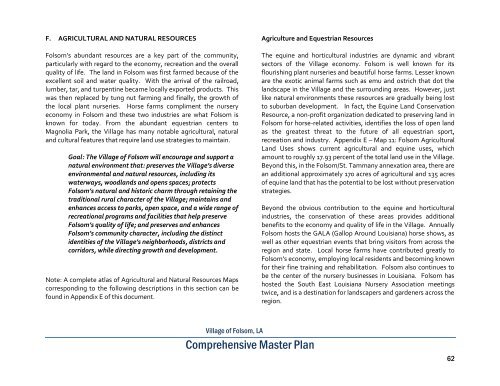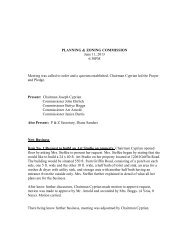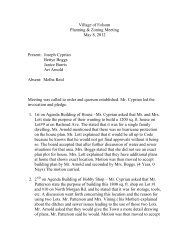Village of Folsom, LA
Village of Folsom, LA
Village of Folsom, LA
Create successful ePaper yourself
Turn your PDF publications into a flip-book with our unique Google optimized e-Paper software.
F. AGRICULTURAL AND NATURAL RESOURCES<br />
<strong>Folsom</strong>’s abundant resources are a key part <strong>of</strong> the community,<br />
particularly with regard to the economy, recreation and the overall<br />
quality <strong>of</strong> life. The land in <strong>Folsom</strong> was first farmed because <strong>of</strong> the<br />
excellent soil and water quality. With the arrival <strong>of</strong> the railroad,<br />
lumber, tar, and turpentine became locally exported products. This<br />
was then replaced by tung nut farming and finally, the growth <strong>of</strong><br />
the local plant nurseries. Horse farms compliment the nursery<br />
economy in <strong>Folsom</strong> and these two industries are what <strong>Folsom</strong> is<br />
known for today. From the abundant equestrian centers to<br />
Magnolia Park, the <strong>Village</strong> has many notable agricultural, natural<br />
and cultural features that require land use strategies to maintain.<br />
Goal: The <strong>Village</strong> <strong>of</strong> <strong>Folsom</strong> will encourage and support a<br />
natural environment that: preserves the <strong>Village</strong>’s diverse<br />
environmental and natural resources, including its<br />
waterways, woodlands and opens spaces; protects<br />
<strong>Folsom</strong>’s natural and historic charm through retaining the<br />
traditional rural character <strong>of</strong> the <strong>Village</strong>; maintains and<br />
enhances access to parks, open space, and a wide range <strong>of</strong><br />
recreational programs and facilities that help preserve<br />
<strong>Folsom</strong>’s quality <strong>of</strong> life; and preserves and enhances<br />
<strong>Folsom</strong>’s community character, including the distinct<br />
identities <strong>of</strong> the <strong>Village</strong>’s neighborhoods, districts and<br />
corridors, while directing growth and development.<br />
Note: A complete atlas <strong>of</strong> Agricultural and Natural Resources Maps<br />
corresponding to the following descriptions in this section can be<br />
found in Appendix E <strong>of</strong> this document.<br />
Agriculture and Equestrian Resources<br />
The equine and horticultural industries are dynamic and vibrant<br />
sectors <strong>of</strong> the <strong>Village</strong> economy. <strong>Folsom</strong> is well known for its<br />
flourishing plant nurseries and beautiful horse farms. Lesser known<br />
are the exotic animal farms such as emu and ostrich that dot the<br />
landscape in the <strong>Village</strong> and the surrounding areas. However, just<br />
like natural environments these resources are gradually being lost<br />
to suburban development. In fact, the Equine Land Conservation<br />
Resource, a non-pr<strong>of</strong>it organization dedicated to preserving land in<br />
<strong>Folsom</strong> for horse-related activities, identifies the loss <strong>of</strong> open land<br />
as the greatest threat to the future <strong>of</strong> all equestrian sport,<br />
recreation and industry. Appendix E – Map 11: <strong>Folsom</strong> Agricultural<br />
Land Uses shows current agricultural and equine uses, which<br />
amount to roughly 17.93 percent <strong>of</strong> the total land use in the <strong>Village</strong>.<br />
Beyond this, in the <strong>Folsom</strong>/St. Tammany annexation area, there are<br />
an additional approximately 170 acres <strong>of</strong> agricultural and 135 acres<br />
<strong>of</strong> equine land that has the potential to be lost without preservation<br />
strategies.<br />
Beyond the obvious contribution to the equine and horticultural<br />
industries, the conservation <strong>of</strong> these areas provides additional<br />
benefits to the economy and quality <strong>of</strong> life in the <strong>Village</strong>. Annually<br />
<strong>Folsom</strong> hosts the GA<strong>LA</strong> (Gallop Around Louisiana) horse shows, as<br />
well as other equestrian events that bring visitors from across the<br />
region and state. Local horse farms have contributed greatly to<br />
<strong>Folsom</strong>’s economy, employing local residents and becoming known<br />
for their fine training and rehabilitation. <strong>Folsom</strong> also continues to<br />
be the center <strong>of</strong> the nursery businesses in Louisiana. <strong>Folsom</strong> has<br />
hosted the South East Louisiana Nursery Association meetings<br />
twice, and is a destination for landscapers and gardeners across the<br />
region.<br />
<strong>Village</strong> <strong>of</strong> <strong>Folsom</strong>, <strong>LA</strong><br />
Comprehensive Master Plan<br />
62




